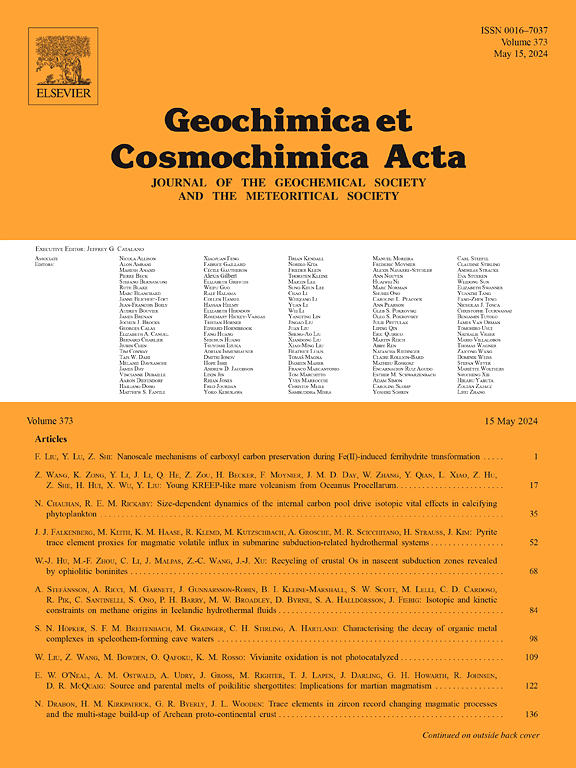187Re-187Os 和高嗜硒元素对含钻石金伯利岩熔体-幔相互作用以及大陆岩石圈推断年龄的研究
IF 5
1区 地球科学
Q1 GEOCHEMISTRY & GEOPHYSICS
引用次数: 0
摘要
距今11.5亿年(Ga)的南非Premier金伯利岩管(库里南钻石矿)由几个不同的金伯利岩面(灰色、棕色、浅黝黑色、深黝黑色、黑色相干[3C型]、蓝/棕色过渡和黄褐色)组成。我们报告了总理金伯利岩面以及一系列夹杂橄榄岩和黑云母异长岩的块岩 Re-Os 同位素数据。这些数据得到了大块岩石高亲硒元素(HSE:Re、Pd、Pt、Ru、Ir、Os)、主要元素和痕量元素丰度的补充。金伯利岩面的 187Os/188Os 测量值范围为 0.1223 至 0.1672(γOsi 为 -2.5 至 +17.4),橄榄岩闪长岩的测量值范围为 0.1096 至 0.1244(γOsi 为 -13.3 至 -1.1),辉长岩闪长岩的测量值范围为 0.1796 至 0.938(γOsi 为 +27 至 +419)。一块经过测量的闪长岩闪长岩的 187Os/188Os 放射性最强,为 2.86(γOsi 为 + 43)。哈兹堡岩的铼耗尽时间模型年龄(TRD)为 1.5 至 2.8 Ga,与 Premier橄榄岩的平均 TRD 年龄(2.4 ± 0.4 Ga)一致。根据这些数据和已公布的数据,我们考虑了金伯利岩和地幔异长岩之间的关系,比较了相对橄榄岩融入的估计值和取样的金刚石品位,并探讨了关于TRD模型年龄的再钙化与再肥化的论点。金伯利岩熔体渗入 Premier橄榄岩斜长岩的情况,从占样品 2 ∼ 14%模数%的熔脉中可以明显看出,这导致了不相容元素的富集,包括 Re 的升高。反过来,金伯利岩的地球化学证据显示,橄榄岩异长岩碎片的加入,3C型的橄榄岩含量比布朗火山碎屑岩层高30%。金伯利岩和橄榄岩绘制了一条 187Re/188Os 与 187Os/188Os 的混合线(R2 = 0.92),金伯利岩的表观年龄比实际结晶年龄大。这条混合线提供了金伯利岩中岩石圈掺入量的估计值,其中橄榄岩掺入量较高的单元与金刚石品级并不相关。这可能是由于金伯利岩单元内的岩性和置换后的蚀变异质性造成的,或许也反映了许多 Premier 钻石的蚀变副成因。橄榄岩为 Premier 岩石圈在 1.15 Ga 以前的性质提供了证据。橄榄岩的变质作用可能与 2 Ga ∼ 的布什维尔德岩浆事件有关,也可能与影响卡普瓦尔陨石坑的其他岩浆事件有关。高级橄榄岩并不表明该地区下面的板块岩石圈已被完全取代。具有新元古代TRD喷发模型年龄的样本可能代表了经历了变质和改造(如在布什维尔德火成岩事件期间)的Archean岩石圈。本文章由计算机程序翻译,如有差异,请以英文原文为准。
A 187Re-187Os and highly siderophile element study of diamondiferous kimberlite melt-mantle interactions and the inferred age of continental lithosphere
The ∼ 1.15-billion-year-old (Ga) Premier kimberlite pipe (Cullinan diamond mine), South Africa, is composed of several distinct kimberlite facies (Grey, Brown, Pale Piebald, Dark Piebald, Black Coherent [Type 3C], Blue/Brown Transitional, and Fawn). We report bulk rock Re-Os isotope data for Premier kimberlite facies, as well as for a suite of entrained peridotite and mafic xenoliths. These data are complemented by bulk rock highly siderophile element (HSE: Re, Pd, Pt, Ru, Ir, Os), major- and trace-element abundances. Measured 187Os/188Os for the kimberlite facies range from 0.1223 to 0.1672 (γOsi of −2.5 to + 17.4), peridotite xenoliths range from 0.1096 to 0.1244 (γOsi of −13.3 to −1.1), and pyroxenite xenoliths range from 0.1796 to 0.938 (γOsi of + 27 to + 419). A single measured amphibolite xenolith has the most radiogenic measured 187Os/188Os of 2.86 (γOsi of + 43). Harzburgite xenoliths yield time of rhenium depletion model ages (TRD) of ∼ 1.5 to 2.8 Ga, consistent with average TRD ages for Premier peridotites (2.4 ± 0.4 Ga). With these and published data, we considered the relationships between kimberlite and mantle xenoliths, compare estimates of relative peridotite incorporation to sampled diamond grade, and explore recratonization versus refertilization arguments with regards to TRD model ages. Kimberlite melt infiltration into Premier peridotite xenoliths is evident from melt veins accounting for ∼ 2 and ∼ 14 modal % of samples, and has led to incompatible element enrichment, including elevated Re. In turn, kimberlites show geochemical evidence for addition of peridotite xenolith fragments, with Type 3C having > 30 % more peridotite contribution than the Brown volcaniclastic facies. Kimberlites and peridotites plot on a 187Re/188Os versus 187Os/188Os mixing line (R2 = 0.92), with kimberlites having older apparent ages than the true age of crystallization. This mixing line provides estimates of lithospheric incorporation into the kimberlites, where the units with higher peridotite incorporation do not correlate with diamond grade. This is likely due to lithological and post-emplacement alteration heterogeneity within the kimberlite units, perhaps also reflecting the eclogitic paragenesis of many Premier diamonds. The peridotites provide evidence for the nature of the lithosphere beneath Premier prior to ∼ 1.15 Ga. Metasomatism of the peridotites is possibly linked to the Bushveld Igneous Event at ∼ 2 Ga, as well as to other magmatic events that affected the Kaapvaal craton from the Archean to the Mesoproterozoic. Premier peridotites do not suggest that the cratonic lithosphere beneath the region was completely replaced. Samples with Proterozoic TRD eruption model ages may represent Archean lithosphere that experienced alteration by metasomatism and modification, such as during the Bushveld Igneous Event.
求助全文
通过发布文献求助,成功后即可免费获取论文全文。
去求助
来源期刊

Geochimica et Cosmochimica Acta
地学-地球化学与地球物理
CiteScore
9.60
自引率
14.00%
发文量
437
审稿时长
6 months
期刊介绍:
Geochimica et Cosmochimica Acta publishes research papers in a wide range of subjects in terrestrial geochemistry, meteoritics, and planetary geochemistry. The scope of the journal includes:
1). Physical chemistry of gases, aqueous solutions, glasses, and crystalline solids
2). Igneous and metamorphic petrology
3). Chemical processes in the atmosphere, hydrosphere, biosphere, and lithosphere of the Earth
4). Organic geochemistry
5). Isotope geochemistry
6). Meteoritics and meteorite impacts
7). Lunar science; and
8). Planetary geochemistry.
 求助内容:
求助内容: 应助结果提醒方式:
应助结果提醒方式:


